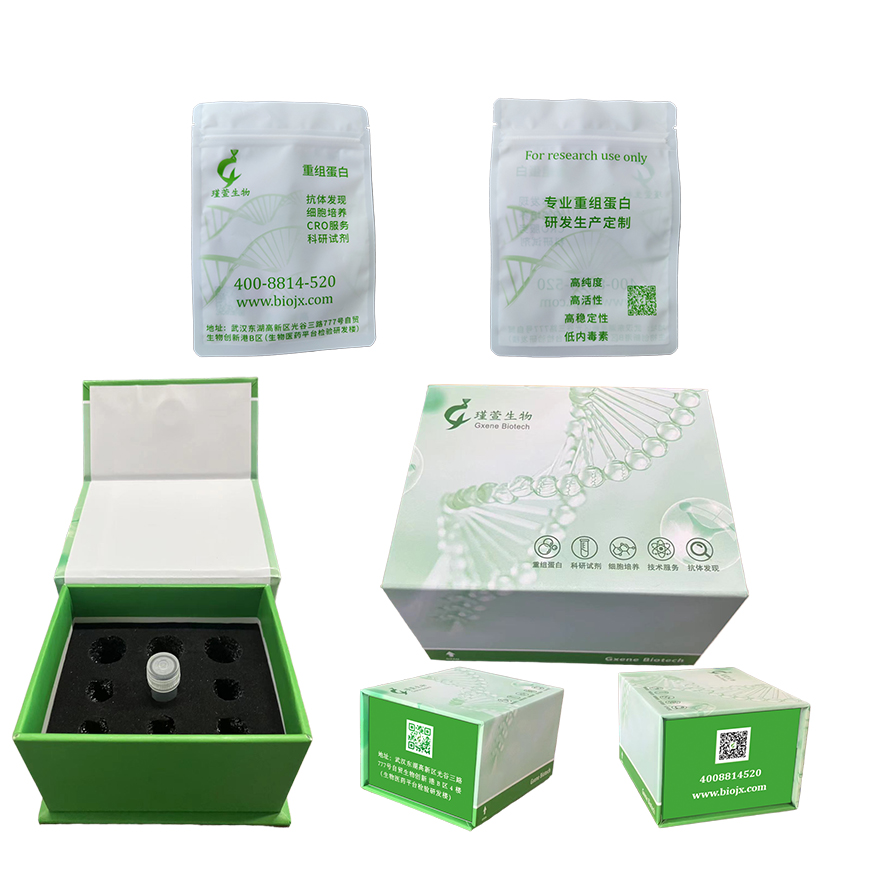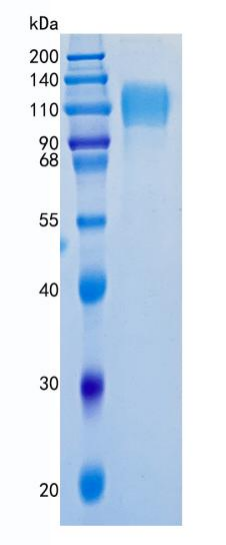研究方向
Human SIGLEC-5(Sialic Acid-Binding Immunoglobulin-Type Lectin 5)是一种免疫球蛋白样凝集素,属于SIGLEC家族。它在免疫调节和细胞间相互作用中发挥重要作用,尤其是在先天免疫和炎症反应中。以下是关于SIGLEC-5的详细信息:
1. 结构与功能
- 结构:SIGLEC-5包含一个细胞外免疫球蛋白样结构域(IgV)、一个跨膜结构域和一个细胞内尾部。细胞内尾部含有免疫受体酪氨酸抑制基序(ITIM),能够传递抑制性信号。
- 功能:SIGLEC-5通过与唾液酸化的糖基配体结合,调控免疫细胞的激活和功能,抑制过度免疫反应。
2. 生物学意义
- 免疫调节:SIGLEC-5在先天免疫细胞(如中性粒细胞和单核细胞)中表达,通过抑制免疫细胞的激活,维持免疫耐受。
- 炎症反应:SIGLEC-5在炎症反应中可能参与调控中性粒细胞的功能,影响炎症的进展和消退。
- 疾病关联:SIGLEC-5的异常表达或功能失调可能与自身免疫疾病、感染和癌症相关。
3. 研究与临床应用
- 研究工具:SIGLEC-5抗体、重组蛋白和基因编辑技术常用于研究其在免疫系统中的功能。
- 潜在治疗靶点:SIGLEC-5可能成为开发免疫调节疗法的新靶点,用于治疗自身免疫疾病和炎症相关疾病。
4. 表达与调控
- 组织分布:SIGLEC-5主要在先天免疫细胞(如中性粒细胞和单核细胞)中表达。
- 调控机制:其表达可能受到细胞因子、病原体相关分子模式(PAMPs)和其他免疫刺激因子的调控。
总结
Human SIGLEC-5是一种重要的免疫调节受体,通过与唾液酸化的糖基配体结合,在先天免疫和炎症反应中发挥关键作用。其在免疫调节和疾病治疗中的潜在应用价值使其成为研究热点。
Measured by the ability of the immobilized protein to support the adhesion of human red blood cells.The ED50 for this effect is 1‑4 µg/mL.
After reconstitution, the protein solution is stable at -20℃ for 3 months, at 2-8℃ for up to 1 week.未开盖的干粉蛋白在 -20°C至-80°C可保存12个月;
复溶之后,蛋白溶液在-20°C及以下可保存3个月,在2-8℃可保存1周。
背景信息
Siglecs (sialic acid binding Ig-like lectins) are I-type (Ig-type) lectins belonging to the Ig superfamily. They are characterized by an N-terminal Ig-like V-type domain which mediates sialic acid binding , followed by varying numbers of Ig-like C2-type domains. Eleven human Siglecs have been cloned and characterized . They are sialoadhesin/CD169/Siglec-1, CD22/Siglec-2, CD33/Siglec-3, Myelin-Associated Glycoprotein (MAG/Siglec-4a) and the Siglec-5 to 11. To date, no Siglec has been shown to recognized any cell surface ligand other than sialic acids, suggesting that interactions with glycans containing this carbohydrate are important in mediating the biological functions of Siglecs. Siglec-5 to 11 share a high degree of sequence similarity with CD33/Siglec-3 both in their extracellular and intracellular regions. They are collectively referred to as CD33-related Siglecs. One remarkable feature of the CD33-related Siglecs is their differential expression pattern within the hematopoietic system. This fact, together with the presence of two conserved immunoreceptor tyrosine-based inhibition motifs (ITIMs) in their cytoplasma tails, suggests that CD33-related Siglecs are involved in the regulation of cellular activation within the immune system. Human Siglec-5 cDNA encodes a 551 amino acid (aa) polypeptide with a hydrophobic signal peptide, an N-terminal Ig-like V-type domain, three Ig-like C2-type domains, a transmembrane region and a cytoplasma tail . Siglec-5 exists as a disulfide-linked homodimer on the cell surface and is expressed on monocytes, neutrophils and B cells . It binds equally well to both alpha 2,3- and alpha 2,6-linked sialic acid .


